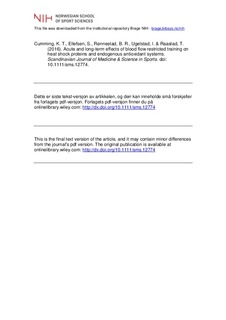| dc.contributor.author | Cumming, Kristoffer Toldnes | |
| dc.contributor.author | Ellefsen, Stian | |
| dc.contributor.author | Rønnestad, Bent | |
| dc.contributor.author | Ugelstad, Ingrid | |
| dc.contributor.author | Raastad, Truls | |
| dc.date.accessioned | 2017-10-17T09:50:28Z | |
| dc.date.available | 2017-10-17T09:50:28Z | |
| dc.date.issued | 2016 | |
| dc.identifier.citation | Scandinavian Journal of Medicine & Science in Sports. 2016. doi: 10.1111/sms.12774 | nb_NO |
| dc.identifier.uri | http://hdl.handle.net/11250/2460527 | |
| dc.description | I Brage finner du siste tekst-versjon av artikkelen, og den kan inneholde ubetydelige forskjeller fra forlagets pdf-versjon. Forlagets pdf-versjon finner du på onlinelibrary.wiley.com / In Brage you'll find the final text version of the article, and it may contain insignificant differences from the journal's pdf version. The definitive version is available at onlinelibrary.wiley.com | nb_NO |
| dc.description.abstract | Blood flow restricted exercise (BFRE) with low loads has been demonstrated to induce considerable stress to exercising muscles. Muscle cells have developed a series of defensive systems against exercise-induced stress. However, little is known about acute and long-term effects of BFRE training on these systems. Nine previously untrained females trained low-load BFRE and heavy load strength training (HLS) on separate legs and on separate days to investigate acute and long-term effects on heat shock proteins (HSP) and endogenous antioxidant systems in skeletal muscles. BFRE and HLS increased muscle strength similarly by 12 ± 7% and 12 ± 6%, respectively, after 12 weeks of training. Acutely after the first BFRE and HLS exercise session, αB-crystallin and HSP27 content increased in cytoskeletal structures, accompanied by increased expression of several HSP genes. After 12 weeks of training, this acute HSP response was absent. Basal levels of αB-crystallin, HSP27, HSP70, mnSOD, or GPx1 remained unchanged after 12 weeks of training, but HSP27 levels increased in the cytoskeleton. Marked translocation of HSP to cytoskeletal structures at the commencement of training indicates that these structures are highly stressed from BFRE and HLS. However, as the muscle gets used to this type of exercise, this response is abolished. | nb_NO |
| dc.language.iso | eng | nb_NO |
| dc.publisher | Wiley | nb_NO |
| dc.subject | occlusion training | nb_NO |
| dc.subject | stress proteins | nb_NO |
| dc.subject | superoxide dismutase | nb_NO |
| dc.subject | glutathione peroxidase | nb_NO |
| dc.subject | chaperonin | nb_NO |
| dc.subject | skeletal muscle | nb_NO |
| dc.subject | strength training | nb_NO |
| dc.title | Acute and long-term effects of blood flow restricted training on heat shock proteins and endogenous antioxidant systems | nb_NO |
| dc.type | Journal article | nb_NO |
| dc.type | Peer reviewed | nb_NO |
| dc.source.journal | Scandinavian Journal of Medicine & Science in Sports | nb_NO |
| dc.identifier.doi | 10.1111/sms.12774 | |
| dc.description.localcode | Seksjon for fysisk prestasjonsevne / Department of Physical Performance | nb_NO |
